By Cornelius Zeeman and Wesley Gardener,
Fairtree Portfolio Manager and Equity Analyst
Imagine finding a pot of gold at the end of the rainbow; franchising might just be that treasure for capital-intensive companies. Franchising is a business model that has been around for decades, thriving especially in the fast-food sector. Franchised fast-food brands have not only survived but thrived within the sector, thanks to the advantages franchising offers (as shown in Graph 1). Examples of these companies include iconic brands like McDonald’s, Domino’s Pizza and Starbucks.
Graph 1: Total US food service market size (US$bn)
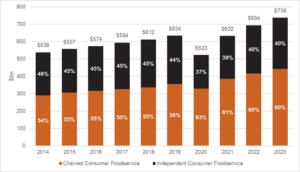
Source: Euromonitor, Bernstein analysis
The franchise model
At its core, franchising involves two key players: the franchisor and the franchisee (see Image 1). The franchisor, who owns the brand and business model, licenses these to the franchisee. Here’s how it generally works:
- Franchise agreement: Franchisees operate under the franchisor’s brand, typically paying a royalty, which is a slice of their revenue.
- Additional fees: Beyond royalties, franchisees might also contribute to national marketing efforts or technological upgrades.
Image 1: Who is a franchisor/franchisee

Source: Fairtree
Benefits of franchising
The franchisor benefits, among other things, by outsourcing its day-to-day operations, having opportunities for faster expansion and access to local expertise.
- The ability to outsource day-to-day operations shifts the responsibility for operating costs from the franchisor to the franchisee. This allows the franchisor to operate with higher profit margins.
- In most cases, the franchisee is responsible for the bulk of the cost of constructing new restaurants (in the context of the fast-food chains). This arrangement eliminates the need for the franchisor to spend its capital on expansion, resulting in a business model that requires less upfront investment. This enables traditional capital-heavy businesses to operate as capital-light entities.
- As franchisors expand into new markets, they often require local knowledge and expertise. This approach significantly increases the geographic reach of the franchising model.
Franchisees also benefit significantly from the franchising model. These benefits include the ability to work under an established brand, utilise a proven business model, and gain access to the brand’s economies of scale, including greater negotiating power with suppliers.
Case study: The franchisor perspective
Using the percentage of the total number of stores franchised versus corporate-owned stores, one can infer the benefit of franchising for the franchisor (i.e., the franchise mix). Simplistically, a higher franchise mix would result in a higher number of franchises relative to corporate stores. McDonald’s, Domino’s Pizza, and Starbucks have varying degrees of franchise mix. How this mix has evolved has directly impacted the company’s operating profitability.
- McDonald’s: Since FY15, McDonald’s made a concerted effort to increase its franchise mix from 82% to 95% by FY23, which coincided with an operating margin jump from 29% to 48% (Graph 2). A higher franchise mix implies less direct operational costs for McDonald’s relative to its revenue earned, leading to higher profitability.
Graph 2: McDonald’s operating profit and franchise mix
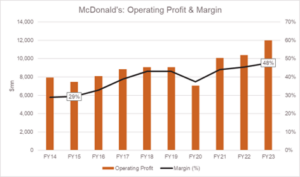
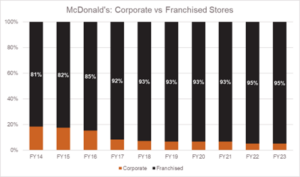
Source: Company data, Fairtree
- Domino’s Pizza: With an already high franchise mix of 97% in FY14, Domino’s increased this to 99% by FY23, correlating with a steady rise in operating margins from 17% to 20% (Graph 3). Domino’s has had a relatively consistent increase in earnings as a result, barring FY22, which was a year defined by persistent inflationary pressures within its supply chain segment.
Graph 3: Domino’s Pizza operating profit & franchise mix
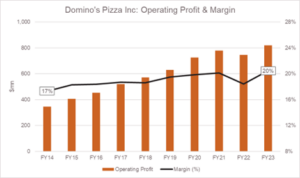
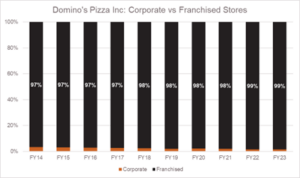
Source: Company data, Fairtree
- Starbucks: Unlike its peers, Starbucks has slightly decreased its franchise mix from 50% in FY14 to 48% in FY24. This has led to less predictable profitability trends (Graph 4). Although margins are influenced by a company’s idiosyncratic factors, a higher franchise mix would better insulate Starbucks from the volatility of underlying store profitability.
Graph 4: Starbucks operating profit & franchise mix
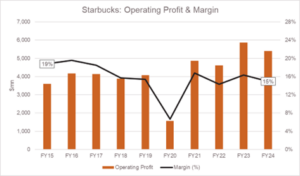

Source: Company data, Fairtree
Conclusion
Franchising has proven to be a transformative business model by enabling capital-heavy companies to operate more efficiently and scale rapidly. By outsourcing operations to local franchisees, franchisors achieve higher margins and expand without significant capital investments. Franchisees, in turn, benefit from established brands and collective economies of scale. Case studies from McDonald’s, Starbucks, and Domino’s highlight how a strong franchise mix supports profitability and growth, underscoring franchising’s enduring appeal.
Topics
We are Fairtree
Subscribe to our newsletter
Stay informed with the latest insights and updates. Subscribe to our newsletter for expert analysis, market trends, and investment strategies delivered straight to your inbox.
"*" indicates required fields

FAIRTREE INSIGHTS
You may also be interested in
Explore more commentaries from our thought leaders, offering in-depth analysis, market trends and expert analysis.

Macro Pulse Episode 21
In this episode Jacobus discusses SA equities, SA bonds and the appreciating of the US dollar.

Fairtree Market Insights with Karena Naidu | Episode 8
In this episode, we dive into our Chinese exposure, exploring what’s happening with the major e-commerce players in China. We also take a closer look at the broader emerging markets space, unpacking key trends and where we’re seeing potential growth.

Macro Pulse Episode 20
In this episode, Jacobus discusses major events leading up to year-end, recent US court cases, and the rise in long bond yields.
Disclaimer
Fairtree Asset Management (Pty) Ltd is an authorised financial services provider (FSP 25917). Collective Investment Schemes in Securities (CIS) should be considered as medium to long-term investments. The value may go up as well as down and past performance is not necessarily a guide to future performance. CISs are traded at the ruling price and can engage in scrip lending and borrowing.
A schedule of fees, charges and maximum commissions is available on request from the Manager. A CIS may be closed to new investors in order for it to be managed more efficiently in accordance with its mandate. Performance has been calculated using net NAV to NAV numbers with income reinvested. There is no guarantee in respect of capital or returns in a portfolio. Prescient Management Company (RF) (Pty) Ltd is registered and approved under the Collective Investment Schemes Control Act (No.45 of 2002). For any additional information such as fund prices, fees, brochures, minimum disclosure documents and application forms, please go to www.fairtree.com.
About you…
By proceeding, I confirm that:
- To the best of my knowledge, and after making all necessary inquiries, I am permitted under the laws of my country of residence to access this site and the information it contains; and
- I have read, understood, and agree to be bound by the Terms and Conditions of Use described below.
- Please beware of fraudulent Whatsapp groups pretending to be affiliated with Fairtree or Fairtree staff members.
If you do not meet these requirements, or are unsure whether you do, please click “Decline” and do not continue.




